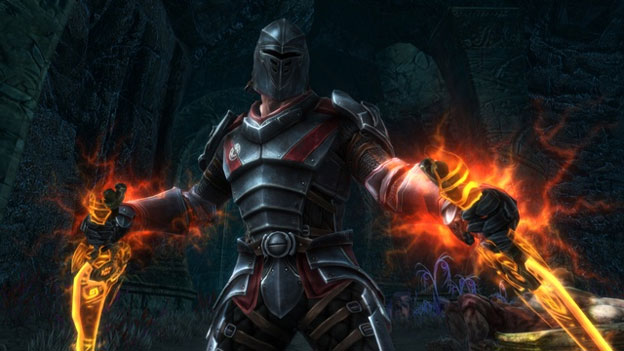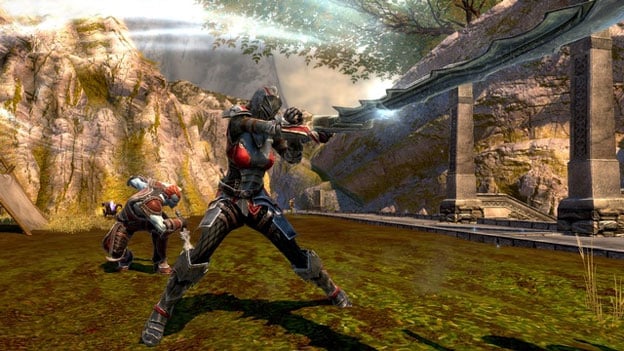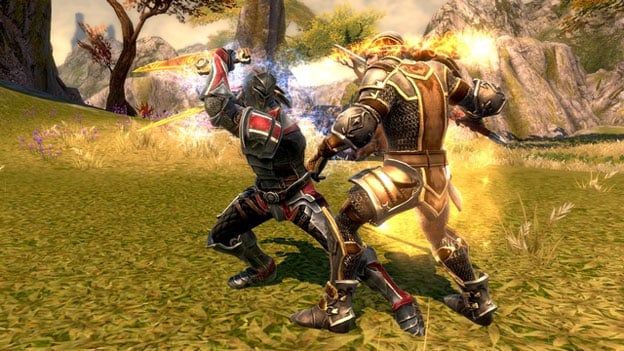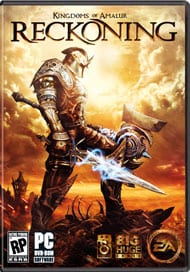It Looks Great, And Feels Even Better.
The RPG genre has its major players—Bethesda, BioWare, and the like—with big ticket entries saturating the media and intimidating smaller scale developers. What typically spawns from the lesser-known studios either flops from poor execution or is clever in design but lacking in content. But every so often we are welcomed by a new studio with the mindset of making a game fun first, which then tackles the technical. The company in this case is 38 Studios, founded by former MLB pitcher Curt Schilling, who has enough personal resources to put together a game he’d enjoy playing.
Sparing little expense, Schilling enlisted fantasy author R.A. Salvatore and cartoonist Todd McFarlane, both giants in their respective fields. Schilling also purchased developer Big Huge Games, which was set to be cut by THQ, forming a capable team, along with designer Ken Rolston, to create the world of Amalur. Their first product, Kingdoms of Amalur: Reckoning is a deep single-player fantasy RPG with a heavy, action-based combat system, a gorgeous world ripe for exploration, and an open class system sure to have every RPG fan praising the heavens.

The story revolves around the Crystal War in a tiny fraction of the ten-thousand-year history created for Amalur, where a dark Fae cult called the Tuatha threatens the land. A casualty of war, your body has been transported to a gnome-run facility in the far west, which houses the Well of Souls, an apparatus designed to resurrect the fallen. The Well has failed in every attempt to bring a soul back. Until you arrived, that is.
Your unique ‘rebirth’ breaks the link between you and your destiny, much to your advantage. Thus the game features a Destiny system that works in tandem with its open class design. Instead of choosing a class right from the start, you’ll earn points as you level up to place into the skill trees of either Might, Finesse, or Sorcery, building a warrior, thief, or mage type, respectively. Points can be placed wherever you like, so if you prefer ice spells but also want to cleave enemies with a massive greatsword, or pickpocket an unsuspecting Tuatha and then smash him with a mighty hammer, you are afforded that luxury. As you invest in particular trees, you will unlock new destiny cards that give your particular skill set a class name, but also award you with boosted statistics and special abilities.

Non-combat skills are also included, with blacksmithing, lockpicking, alchemy, and mercantile, just to name a few. You are granted a single point at each new level to place into one of these skills, and each can be improved ten times. There are also trainers who can upgrade your skills, albeit for a hefty price.
But if after a hundred hours of playing a pure fighter you decide you want to try your hand at spellcasting, don’t fret. NPCs called Fateweavers will (for a price) reset both your combat and non-combat skills, allowing you to completely re-customize your character.
The combination of skills is impressive, and, from your first to your millionth foray into battle, you’re probably not going to get tired of it. That’s because unlike many other fantasy role-playing games, Kingdoms of Amalur: Reckoning delivers possibly the most addictive action combat yet. Dodging and blocking, timing your attacks, and learning each enemy’s tactics require a quick mind and quick hands. Perfectly mapped actions mean you can switch between primary and secondary weapons, bash with your shield, launch a meteor storm, and drink a healing potion without having to pause or enter any menu screens. But the fluidity does nothing to diminish the intensity, as you’ll often find yourself flanked and overwhelmed by monstrous foes. The killer move occurs when your fate bar becomes full, allowing you to enter Reckoning mode. Here, time slows and your attacks strengthen, climaxing to a random but thoroughly satisfying finishing move called a Fateshift, which also bears additional experience points.

Although the combat truly shines brighter than any other RPG in the past, Kingdoms of Amalur: Reckoning is still an immensely robust adventure with hundreds of hours of content. Considered an open world experience, Reckoning is more bound to parameters than you’d think. You won’t be able to, for instance, finish the tutorial dungeon and immediately set your auto-run to the other end of the continent. Instead, each zone is contained, with a few narrow paths leading to adjoining areas. However, each of these zones is a relatively circular free-roaming environment, so you’ll never feel like you’re being guided down a narrow corridor. Within each region you’ll find many towns, or perhaps a city, each offering you a place to relax, shop, ply your trade, or take up a plethora of quests. While some will inevitably feel like fetch or kill quests, there’s enough lure and promise of rewards to keep you interested in every one.
But Kingdoms of Amalur does falter when it comes to story and the characters, and does so in many respects. Despite Salvatore’s “creation” of Amalur through written lore, the scripting and execution of conversations feel disjointed. Every plot character you talk to will discuss your topics at length, but the discussion is completely one-sided as you have no opinion, save for a sporadic reply at times to indicate agreement or disagreement. And even then, neither choice has dire consequences or sends the plot in a new direction. The voice acting only accentuates this flaw, where again we have a world full of vibrant and opinionated characters (which thankfully lacks redundancy in the casting), and yet the most important character—you—is a mute.
But not only that, while the NPCs spill their praise or disdain with vocal and physical inflections, your stature remains neutral, with a rigid composure and vacant expression. This lack of connection to the character you’re following for possibly hundreds of hours completely removes any amity you feel towards his or her pursuit. There is also no companion system, save for an odd quest where the computer-controlled ally tackles a dungeon alongside you for their own inscrutable purposes and then promptly bids you adieu. The lack of a fellowship gives us no diversity in attitudes, no long-term characters we can grow affection for, and a solo campaign that has you moving from quest to quest feeling like little more than an errand boy (or girl).

The rest of the music and sound blend perfectly with the world. The score fills the background ambience without being too intrusive, and the bass and percussion pick up nicely during boss fights and more intense scenes. Every strike, no matter which weapon you’re using, resounds with perfect weight, and you’ll never feel shortchanged as you slash, incinerate, or pummel your enemies to a pulp.
The world of Amalur looks absolutely gorgeous, whether you’re traversing a lush forest or a barren wasteland, it’s just plain beautiful. It’s a welcome change compared to more recent RPGs that lean towards the realism, which often means tons of gray. It seems like 38 Studios made an effort to use every bold color in the spectrum, and things just pop as a result. The crafting of the enemies is also top-notch, and each has such a distinctive look and presence that you’ll never grow bored hacking your adversaries to bits. The fine detailing is where the graphics seem to lessen in quality, especially obvious in the character models when having a conversation. The facial design matches the overall aesthetic of the game, but you certainly won’t spot wrinkles, freckles, and other minutia that would give believability to the world’s inhabitants.
While not the first game to be called a hybrid of action and RPG, it certainly is the hallmark of the former, with the robust content that’s generally expected of the latter. If you were hoping to be connected to the characters like you did in some of R.A. Salvatore’s great fantasy novels, you will undoubtedly be disappointed. But Amalur is still a beautiful and immense world with plenty of secrets to discover and combat that is ceaselessly satisfying.
RATING OUT OF 5 RATING DESCRIPTION 4.6 Graphics
A gorgeous world and amazing combat animations. The lack of fine details in the character models does hinder the quality slightly. 5.0 Control
The absolute pinnacle of fluid combat in any game, ever! Perfectly mapped actions and reflexive strategy makes every battle a blast. 4.6 Music / Sound FX / Voice Acting
The music and sound effects are perfect, and a fairly diverse cast limits the vocal reuse. The fact that your character doesn’t speak, though, is a disappointment. 4.5 Play Value
What the game lacks in an emotional connection, it more than makes up for in hundreds of hours of content. 4.6 Overall Rating – Must Buy
Not an average. See Rating legend below for a final score breakdown.
| Review Rating Legend | |||
|---|---|---|---|
| 0.1 – 1.9 = Avoid | 2.5 – 2.9 = Average | 3.5 – 3.9 = Good | 4.5 – 4.9 = Must Buy |
| 2.0 – 2.4 = Poor | 3.0 – 3.4 = Fair | 4.0 – 4.4 = Great | 5.0 = The Best |
Game Features:
